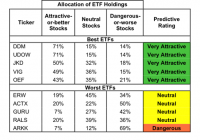6 ETFs With The Largest Exposure To Netflix
Summary 6 ETFs have more than 2% of total assets dedicated to Netflix. Some have exposure as high as 7%. Netflix plunged almost 9% on Thursday, thanks to an earnings report that missed on both revenue and subscriber growth estimates. The size of some of the ETFs listed is very small and thus may face liquidity and tradeability issues. Netflix (NASDAQ: NFLX ) made news this week when it delivered its third-quarter earnings report. The company reported disappointing revenue and subscriber growth, and as a result, the stock dropped over 8% on the day. NFLX has been a very popular momentum stock not just among individual investors, but by ETFs as well. There are 6 ETFs that currently have at least a 2% weighting in Netflix. Some are significantly higher than that, and any ETF that had a large exposure to Netflix on Thursday likely had trouble matching the broader market’s performance. Each of these ETFs is primarily technology and Internet focused, and as a result, is riskier than the average broad equity market fund. Keep in mind that these weightings can change over time, but if you’re looking for exposure to Netflix, these ETFs would be the place to start. PowerShares NASDAQ Internet Portfolio (NASDAQ: PNQI ) – 7.47% weighting While this ETF has the largest weighting of Netflix stock in its portfolio, it shouldn’t be too surprising given how concentrated this portfolio is. It has 95 positions in the portfolio, but the top 10 holdings account for 60% of the fund’s assets. In fact, NFLX is only the 5th largest holding. Despite its significant weight in Netflix, this ETF still performed comparably to the NASDAQ on Thursday. It was up 1.3% compared to the NASDAQ 1.8% gain. SPDR Morgan Stanley Technology ETF (NYSEARCA: MTK ) – 6.04% weighting In this ETF, Netflix is the top dog. With just 37 holdings, this fund is also concentrated but weightings tend to be distributed a little more evenly. This fund has the added benefit of also being one of the cheapest. Its 0.35% expense ratio falls well below the 0.59% average ETF ratio. The heavy Netflix weighting helped weigh down this ETF’s performance Thursday. It managed a gain of just 0.3% on a day when technology stocks as a whole moved broadly higher. First Trust DJ Internet Index ETF (NYSEARCA: FDN ) – 5.44% weighting Another concentrated technology ETF, this fund has nearly 60% of assets in its top 10, and Netflix is just the 3rd largest holding here. This fund is easily the largest among the ETFs on this list at nearly $3.6 billion in assets, so this fund will be the most liquid and easiest to trade. This ETF nearly matched the pace of the NASDAQ on Thursday, rising nearly 1.5%. First Trust ISE Cloud Computing Index ETF (NASDAQ: SKYY ) – 4.47% weighting As an ETF index provider, ISE is probably better known for the PureFunds ISE Cyber Security ETF (NYSEARCA: HACK ) that’s garnered over $1 billion in assets in a short period of time, but this fund is slowly gaining notoriety in its own right. This fund’s composition is fairly similar to the Dow Jones Internet Index Fund – concentrated and roughly equal weighted – but it’s significantly smaller and hasn’t performed nearly as well. This fund wasn’t hit terribly hard by its Netflix position as it still delivered a 1.5% gain on Thursday. Ark Web x.0 ETF (NYSEARCA: ARKW ) – 3.88% weighting Here’s where we start getting into the really small ETFs. This fund has just $12 million in assets and is very thinly traded. Typically, trading just a few hundred shares a day, liquidity is a significant issue, and the costs of trading may be too high. Despite the fact that ARKW is about a year old but hasn’t really caught on it still makes the list for its large position in Netflix. This is the only ETF on the list that was actually down on Thursday. Ark Innovation ETF (NYSEARCA: ARKK ) – 2.83% weighting This ETF also from the Ark Investment Management family is even smaller than the one listed above with just $8 million in assets. Pretty much everything mentioned above with the Web x.0 ETF applies here as well. This fund manages to eke out a tiny gain on Thursday based on just one 100 share trade.
